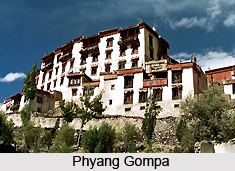 In Phyang, the Gompa emerges at the head of a remote side-valley that turns narrow into the North of the Ladakh range from the Srinagar highway. Phyang gompa is located at a mere distance of just 17 km in the West of Leh. There are eight buses that serve for visiting Gompa in which three buses consists of government that are in shabby and scruffy condition. And if you miss returning bus to your way don`t worry and path the downwards smooth road and flag down the bus that will go to Leh.
In Phyang, the Gompa emerges at the head of a remote side-valley that turns narrow into the North of the Ladakh range from the Srinagar highway. Phyang gompa is located at a mere distance of just 17 km in the West of Leh. There are eight buses that serve for visiting Gompa in which three buses consists of government that are in shabby and scruffy condition. And if you miss returning bus to your way don`t worry and path the downwards smooth road and flag down the bus that will go to Leh.
The Phyang Gompa resides a fifty-strong community of lamas, but few antique murals of note, are the new recently painted fresco or wall paintings painted over with bright colours. Today its only treasures are a small collection of Kashmiri bronzes that is now locked behind glass in the modern Guru-Padmasabhava temple and the light and airy Du-Khang`s three silver chortens, one of which is ornamented with a seven-eyed Dzi stone. The gem, which was considered to be highly auspicious, was brought here from Tibet by the monastery`s earlier head lama. Its ruins now enclose the chorten. Spread around the sides of temple, the temple in the gompa`s glooming atmosphere Gon-Khang dwells a fierce disguised protector deity and an amazing collection of weapons and armour that was stealed during the mongol invasion during the fourteenth century. Here clinging from the cobweb covered rafters are various bits of dead animals especially including are the vultures and sets of yak horns which is considered to be at least 900 years old observing the ruins of the bon cult.
Phyang`s annual festival, Phyang Tsedup, which is celebrated during mid July and early August, coincides with the tourist season. This is considered to be the second large festival after the festival of Hemis. This is also celebrated in the usual traditional form where traditional dancers perform their masked chaam dances and the event is also marked by the ritual exposition of a giant ten-metre brocaded silk Thangka.



















